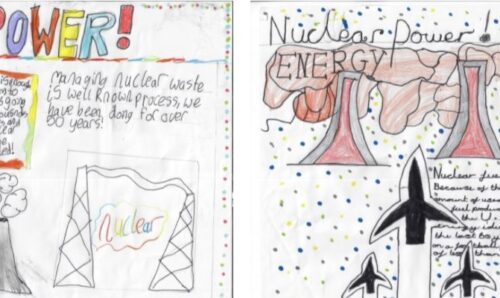
Fake it till you make it: Sitting with experts
Author: Ted Hicks, PhD student, The University of Manchester. As a PhD student on the Fusion CDT, a joint program between The University of Manchester and other UK universities, I was lucky enough to be given the opportunity to be the student voice on a panel about developing nuclear fusion regulation in the UK. I’d […]

Taking nuclear research to primary school
Author: Megan Watters, PhD student, The University of Manchester. Earlier this month, a few of the Dalton Nuclear Institute researchers went on an outreach road trip to the leafy village of Rode Heath in Cheshire. We first had a great talk from James, introducing the topic of nuclear energy to the primary school students. It […]

Turning Fusion from a Dream to a Reality
Author: Dr. Aneeqa Khan, Research Fellow in Nuclear Fusion. Nuclear fusion is the process that drives the sun. Unlike traditional nuclear power which involves splitting nuclei, fusion fuses nuclei together, liberating huge amounts of energy. It has the potential to be an abundant source of power that has very low carbon dioxide emissions While fusion […]

An Introduction to Nuclear Regulation in the UK
On the surface, nuclear regulation within the UK appears to be a complicated web of acts, laws, regulatory bodies and acronyms. Hopefully, this breakdown will help to demystify this important aspect of our nuclear and radiological industries. In order to regulate an industry, there needs to be rules which govern the activities and there needs […]

Nuclear Research: Water Radiolysis and Corrosion Science
The most common type of nuclear reactor worldwide is the pressurised water reactor (PWR).[1] This design uses two discrete water coolant systems, termed the primary and secondary coolant loop. The primary coolant passes through the reactor core where nuclear fission takes place, ultimately transferring heat to the secondary coolant loop for thermal energy conversion to […]

Nuclear Research: Waste Disposal Drivers
‘Waste Disposal Drivers for a Range of Nuclear Power Systems’ is my PhD title, but like many PhD titles, this doesn’t give much insight into what I actually do. In real words, the project involves quantitatively assessing five nuclear fuel cycles to draw comparisons between them, focusing on properties and masses of spent fuel, the […]

Nuclear Research: Minerals, Sulfide, and Radwaste Disposal
Nuclear and radiochemistry research is a diverse and unique field of study. This month we’ve asked some PhD students to summarise their research and how this may apply to the nuclear industry. Luke Townsend discusses his work on the ‘Long-term Fate of Radionuclides during Sulfidation’. When anyone mentions nuclear power, one of the first issues people […]

History of the radiation warning symbol
Recently, I was asked the intriguing question: “where did the black and yellow symbol for radioactivity come from?” What surprised me was that, despite using it almost every day in the lab, I hadn’t even considered its origin before now. So I did some digging. The life of the radioactive ‘trefoil’ began in 1946 at […]

Wylfa Newydd: Why the opposition?
The recent protests against the proposed Wylfa Newydd nuclear power station have brought to the media’s attention a very pressing issue: lots of people don’t want to live near nuclear power stations. While public support for nuclear power outweighs opposition [1], proposed nuclear sites often face resistance from local communities. This is despite the promises […]

Chernobyl Zone of Alienation
Having discussed the engineering and installation of the Chernobyl NSC, it is important to keep in mind the lasting impact of the accident on the local population and the surrounding environment. Ellis Rintoul examines the Chernobyl exclusion zone and the future of this vast area of contaminated land. The Zone of Alienation, commonly known as the […]

